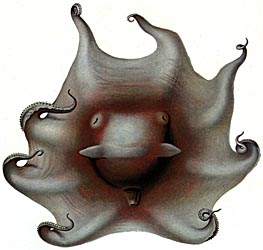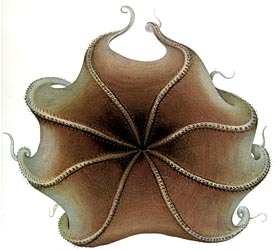Opisthoteuthis
Flapjack devilfishes
Roger Villanueva, Richard E. Young, and Michael Vecchione- Opisthoteuthis agassizii Verrill, 1883
- Opisthoteuthis albatrossi (Sasaki, 1920)
- Opisthoteuthis bruuni Voss, 1982
- Opisthoteuthis californiana Berry, 1949
- Opisthoteuthis calypso Villanueva, Collins, Sanchez and Voss 2002
- Opisthoteuthis chathamensis O'Shea, 1999
- Opisthoteuthis depressa Ijima & Ikeda, 1895
- Opisthoteuthis extensa Thiele, 1915
- Opisthoteuthis grimaldii Joubin, 1903
- Opisthoteuthis hardyi Villanueva, Collins, Sanchez and Voss 2002
- Opisthoteuthis massyae (Grimpe, 1920)
- Opisthoteuthis medusoides Thiele, 1915
- Opisthoteuthis mero O'Shea, 1999
- Opisthoteuthis persephone Berry, 1918
- Opisthoteuthis philipii Oommen, 1976
- Opisthoteuthis pluto Berry, 1918
- Opisthoteuthis robsoni O'Shea, 1999
Introduction
Species of Opisthoteuthis are the most compressed, in the anterior-posterior axis, of any cephalopod. This flattened appearance gives them the common name of flapjack or pancake devilfish. Species are thought to be primarily benthic although they are capable of swimming and in some species the swimming may be an important component of their pouncing on minute prey. As in other cirrates, most species are poorly known.
Diagnosis
Opisthoteuthids ...- with one or two fields of enlarged suckers on arms of mature males.
- with small fins.
- with areolae present at least in young. (Needs confirmation.)
- with kidney-shaped optic lobe.
- with white body penetrated by two or more separate optic nerve bundles.
- with U-shaped shell.
- without tooth-like structures in sucker aperature.
Characteristics
- Arms and web
- Arms of males generally with modified suckers (i.e., enlarged and often with complex alignment) in one or two fields (proximal and distal).
- Cirri short (in preserved animals).
- Cirri may be retractile into pockets. The retractile (rather than just contractile) nature of the cirri has been suggested by several authors due to their appearance in preserved animals. However, this attribute remains uncertain.
- Web nodules (= web supports; these are often difficult to detect) present as multiple or single nodules or absent.
 image info
image info Figure. Oral view of Opisthoteuthis grimaldii (?). Photograph shows multiple web nodules, some of which are indicated by the arrows. Also note the rather long cirri in this live Opisthoteuthis. Photograph from a submersible.
- Fins
- Small, length approximately half mantle width.
- Small, length approximately half mantle width.
- Gills
- Half-orange appearance.
- Half-orange appearance.
- Digestive tract
- Intestine approximately 1.5 - 2.0 times esophagus (and crop) in length. Digestive tract not a simple loop (i.e., intestine makes lateral bends and/or loops.
- Digestive gland bilobed or unilobed.
- Radula absent.
- Eyes
- Large, diameter often 60-70% of ML, 50% of head width.
- Large, diameter often 60-70% of ML, 50% of head width.
- Optic nerve tract
- Two or more bundles penetrate white body.
- Two or more bundles penetrate white body.
- Optic lobe
- Kidney-shaped in cross-section.
- Kidney-shaped in cross-section.
- Shell
- U-shaped, lateral walls of wings not parallel (i.e., spread between walls increases toward tips).
- Outer surface of saddle usually with groove (narrow or broad, shallow or deep); outer surface rarely flat.
- Wing frequently terminates as elongate, simple, pointed cone; termination complex in some species.
- Pigmentation
- Areolar spots present. In some species these are difficult to detect or absent.
 image info
image info Figure. Side view of Opisthoteuthis agassizii. Photograph from submersible. In this photograph, the lines of white areolar spots are easily seen, especially on the arms.
| Mature males | Both sexes | |||||||||||
| Species | Arm I more robust | Prox. field: No. of suckers | Distal field: No. of suckers | Prox. field: Arm no. | Distal field: Arm no. | Distal field: Largest sucker, mean position | DESD> PESD ** | Arm sucker counts | Funnel organ | Web supports | Digest. gland bilobed | Ocean |
|---|---|---|---|---|---|---|---|---|---|---|---|---|
| O. agassizii | No | 5 | 7-8 | I-IV | I-IV | 34-36 | No/yes | 58-80 | V-shape | Multiple | No | W.N. Atlantic |
| O. albatrossi | No | 0 | 3 | None | I | ? | Yes | 80 | ? | Single? | Yes | N. Pacific |
| O. bruuni | No | 3 | 2-3 | I-IV | I-IV | 24-27* | No | ? | 2 pads | ? | ? | E. S. Pacific |
| O. californiana | No | 8-10 | 3-8 | I-IV | I | ca. 27 | Yes | ? | 2 pads | ? | ? | N. Pacific |
| O. calypso | No | 2-6 | 2-3 | III | I-IV | 26-27 | Yes | 47-58 | 2 pads | Single | No | E. Atlantic |
| O. chathamensis | No | 5-7 | 6-8 | I-IV | I-IV | ca 22 | Equal? | 41-55 | V-shape | ? | Yes | W. S. Pacific |
| O. depressa | No | 16 | 0 | I-IV | None | -- | No | 50 | ? | Absent? | ? | W. N. Pacific |
| O. extensa | ? | ? | ? | ? | ? | ? | ? | ? | ? | ? | ? | E. Indian |
| O. grimaldii | No | 4-11 | 9-10 | I-IV | I-IV | 29-31 | No | 73-80 | 2 pads | Single | Yes | E. Atlantic |
| O. hardyi | Slight | 4-9 | 9-14 | I-IV | I-IV | 22-24 | Equal | 60-67 | ? | Absent | No | high S. Atlantic |
| O. massyae | Yes | 7-8 | 9-11 | I-IV | II-IV | 40-41 | No | 81-106 | 2 pads | Multiple | Yes | E. Atlantic |
| O. medusoides | ? | ? | ? | ? | IV | ? | ? | ? | ? | ? | ? | W. Indian |
| O. mero | No | 5-8 | ? | I-IV | None | -- | No | 54-71 | V-shape | ? | Yes | W. S. Pacific |
| O. persephone | ? | ? | ? | ? | ? | ? | ? | 93 | ? | ? | Yes | Off S. Aust. |
| O. philipii | ? | 5-11 | ? | ? | ? | ? | ? | ? | V-shape | Single | ? | NW Indian |
| O. pluto | ? | ? | 3-4 | ? | II-IV | ? | No? | 80-85 | 2 pads | ? | Yes | Off S. Aust. |
| O. robsoni | No | 7-8 | ? | I-IV | None | -- | No | 74-89 | V-shape | ? | No | W. S. Pacific |
*From illustration. ** DESD = Distal field enlarged sucker diameter; PESD = Proximal field enlarged sucker diameter. For the purposes of this table, a distal field is considered to be absent if suckers there do not show a distinct enlargement.
Nomenclature
Cirroteuthis caudani Joubin, 1896 appears to be a species of Opisthoteuthis [probably O. grimaldii or O. massyae according to Martin Collins, pers. comm., 2002] but the type is apparently lost (Villanueva et al., 2002)
References
Chun, C. 1915. Die Cephalopoden. Myopsida, Octopoda. Wissenschaftliche Ergebnisse der Deutschen Tiefsee-Expedition, "Valdivia" 1898-1899, 18 (2): 405-522 + Atlas.
O'Shea, Steve. 1999. The Marine Fauna of New Zealand: Octopoda (Mollusca: Cephalopoda). NIWA Biodiversity Memoir 112: 280pp.
Sweeney, M.J. 2001. Current Classification of Recent Cephalopoda. pdf file, 59 pp.
Villanueva, R. 1992. Continuous spawning in the cirrate octopods Opisthoteuthis agassizii and O. vossi: features of sexual maturation defining a reproductive strategy in cephalopods. Marine Biology, 114:265-275.
Villanueva, R., Collins, M., Sanchez, P. and N. Voss. 2002. Systematics, distribution and biology of the cirrate octopods of the genus Opisthoteuthis (Mollusca, Cephalopoda) in the Atlantic Ocean, with description of two new species. Bulletin of Marine Science 71(2):933-985.
Voss, G. L. and W. G. Pearcy. 1990. Deep-water octopods (Mollusca: Cephalopoda) of the Northeastern Pacific. Proc. Calif. Acad. Sci. 47: 47-94.
Title Illustrations
| Scientific Name | Opisthoteuthis extensa |
|---|---|
| Reference | from Thiele in Chun, C. 1915. Die Cephalopoden. Myopsida, Octopoda. Wissenschaftliche Ergebnisse der Deutschen Tiefsee-Expedition, "Valdivia" 1898-1899, 18 (2): 405-522 + Atlas. |
| View | Aboral |
| Type | Holotype |
About This Page
Instituto de Ciencias del Mar (CSIC)
Paseo Juan de Borbon s/n
E-08039 Barcelona
Spain
Richard E. Young
Dept of Oceanography
University of Hawaii
Honolulu, Hawaii 96822
USA
National Marine Fisheries Service
Systematics Laboratory
National Museum of Natural History
Washington, D. C. 20560
USA
Page copyright © 2003 , Richard E. Young, and
- First online 13 May 2003
Citing this page:
Villanueva, Roger, Young, Richard E., and Vecchione, Michael. 2003. Opisthoteuthis . Flapjack devilfishes. Version 13 May 2003 (under construction). http://tolweb.org/Opisthoteuthis/20106/2003.05.13 in The Tree of Life Web Project, http://tolweb.org/










